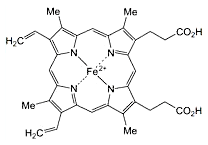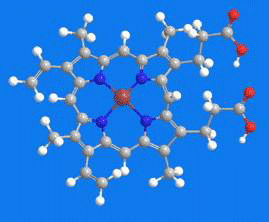

Heme, a porphyrin derivative, is the color component of hemoglobin, which is responsible for transporting oxygen in blood. It was isolated by E. Bertin-Sans and J. de Moitessier in 1892. In 2010, M. P. Soares and coauthors reported that infections can release free heme from hemoglobin, which leads to heme-promoted tissue damage and severe sepsis.
MOTW update:
February 5, 2024
Heme1 is a porphyrin derivative and the color component of hemoglobin, which transports oxygen in blood.
Last month, Frances H. Arnold, Kendall N. Houk, and colleagues at Caltech (Pasadena, CA) and the University of California, Los Angeles, described a potential use for heme in organic synthesis. They used computational chemistry to determine the mechanism of iron heme enzyme–catalyzed carbene transfer reactions to synthesize cyclopropane derivatives. The advantage of this method is that the carbene precursors are diazirines, which are air-stable, user-friendly alternatives to traditionally used diazo compounds.
1. CAS Reg. No. 14875-96-8.

Learn more about this molecule from CAS, the most authoritative and comprehensive source for chemical information.
Molecule of the Week needs your suggestions!
If your favorite molecule is not in our archive, please send us a message. The molecule can be notable for its current or historical importance or for any quirky reason. Thank you!
Stay Ahead of the Chemistry Curve
Learn how ACS can help you stay ahead in the world of chemistry.

